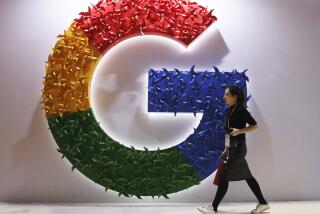Apple launches ad system for mobile devices in race with Google
- Share via
In a direct attack on Silicon Valley rival Google Inc., Apple Inc. unveiled its new mobile advertising system Thursday and promised to deliver a new generation of compelling interactive ads to its devices.
Chief Executive Steve Jobs announced Apple’s iAd advertising network as one of a raft of features coming later this year to its iPhone, iPad and iPod Touch line.
By building an advertising system into its products, Jobs said, Apple is hoping to tap into a nascent but potentially lucrative market: the growing number of consumers who are picking up a cellphone when they want to access the Internet.
Analysts predict that within five years, more users will access the Internet from mobile devices than personal computers, which could translate into billions of dollars in sales of phones, software and services.
Spending on mobile advertising in the U.S. last year was about $416 million, and it is expected to climb to more than $1.5 billion by 2013, according to research firm EMarketer. Online advertising generated $24 billion last year, the firm said.
That has led to Apple and Google racing against one another to build competing mobile advertising platforms. Their goal is simple: Whether people are reading on computer tablets at home, talking on cellphones in the car or listening to music players while walking down the street, advertisers can always reach them.
What such marketing campaigns will look like, or how they will let people interact with media-rich ads, is still in the early stages. At Apple headquarters in Cupertino, Calif., Jobs showed some examples of what was possible with ads for the upcoming “Toy Story” movie, Nike Air sneakers and Target: The ads more closely resembled small, touchable multimedia games than traditional static Web ads.
Even before the launch of iAd, Apple had a substantial head start in the mobile marketplace: The company sold more than 85 million iPhones and iPod Touch players in the last three years. That success has attracted an army of software developers, who have built 185,000 applications for Apple’s hand-held devices.
Users have performed 4 billion application downloads since the earliest became available in 2008, Jobs said.
“Search is not happening on phones,” Jobs said, in a direct jab at Google.
“People are using apps, and this is where the opportunity is to deliver advertising.”
Analysts say Google is likely to match Apple by offering developers more incentives to build applications for devices that run on its Android mobile operating system. The Android store has more than 30,000 applications available for download. (Google executives declined to disclose the number of apps that consumers have downloaded for Android-based devices.)
Aaron Stein, a spokesman for Google, acknowledged Thursday that Apple’s move “is more evidence of how quickly mobile advertising is evolving and growing.”
Along with the iPad tablet computer Apple released Saturday -- it has sold 450,000 units so far -- the company is now hoping to offer a broader technical palette to advertisers. In turn, they would be able to design larger, more colorful ads that users can interact with.
Yet Google poses serious competition. The company, which has built a vast empire on its Internet ads, has been selling search ads on phones and on mobile Web pages for years -- albeit with limited success.
Google made an aggressive move to dominate mobile advertising in November when it outmaneuvered Apple to buy the largest independent mobile advertising network, AdMob Inc.
Yet the pending $750-million acquisition is being held up by federal regulators, who are concerned that it would give Google, already the leader in Internet search advertising, too much of an advantage in an emerging but crucial new sector.
If regulators greenlight Google’s acquisition of AdMob, Google would claim an estimated 21% of the U.S. mobile advertising market, according to IDC research analyst Karsten Weide.
A Federal Trade Commission spokesman declined to comment Wednesday.
However, the investigation is ramping up, according to media reports. On Tuesday, U.S. Sen. Herb Kohl (D-Wis.) sent a letter to the FTC urging close scrutiny of the deal, which “raises important competition issues.”
Determining whether the acquisition could harm competition in such a nascent market could be difficult, said David Balto, a former antitrust attorney for the Justice Department and the FTC. Regulators are expected to decide within the next month whether they will challenge the deal, he said.
Google has contended that mobile advertising is already bursting with competition, and points to Apple’s $275-million acquisition in January of Quattro Wireless of Waltham, Mass. Quattro provided the foundation for Apple’s iAd platform.
AdMob and Quattro Wireless are just two of a dozen mobile networks that sell ads designed to be displayed on Apple’s iPhone and devices that run on Google’s Android mobile operating system.
Apple’s iAd network could help assuage regulators’ concerns, Weide said.
“It makes the argument more credible that there is a healthy level of competition,” he said.






